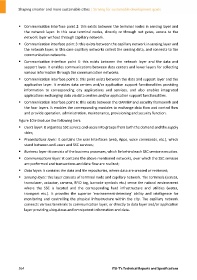Page 374 - Shaping smarter and more sustainable cities - Striving for sustainable development goals
P. 374
Communication interface point 2: this exists between the terminal nodes in sensing layer and
the network layer. In this case terminal nodes, directly or through net gates, access to the
network layer without through capillary network.
Communication interface point 3: this exists between the capillary network in sensing layer and
the network layer. In this case capillary networks collect the sensing data, and connects to the
communication networks.
Communication interface point 4: this exists between the network layer and the data and
support layer. It enables communications between data centers and lower layers for collecting
various information through the communication networks.
Communication interface point 5: this point exists between the data and support layer and the
application layer. It enables data centers and/or application support functionalities providing
information to corresponding city applications and services, and also enables integrated
applications exchanging data via data centers and/or application support functionalities.
Communication interface point 6: this exists between the OAM&P and security framework and
the four layers. It enables the corresponding modules to exchange data flow and control flow
and provide operation, administration, maintenance, provisioning and security function.
Figure 10 introduce the following tiers:
Users layer: it organizes SSC service end‐users into groups from both the demand and the supply
sides;
Presentations layer: it contains the user interfaces (web, Apps, voice commands, etc.), which
stand between end‐users and SSC services;
Business layer: it consists of the business processes, which lie behind each SSC service execution.
Communications layer: it contains the above mentioned networks, over which the SSC services
are performed and transactions and data flow are realized;
Data layer: it contains the data and file repositories, where data are created or retrieved;
Sensing layer: this layer consists of terminal node and capillary network. The terminals (sensor,
transducer, actuator, camera, RFID tag, barcode symbols etc.) sense the natural environment
where the SSC is located and the corresponding hard infrastructure and utilities (water,
transport etc.). It provides the superior 'environment‐detecting' ability and intelligence for
monitoring and controlling the physical infrastructure within the city. The capillary network
connects various terminals to communication layer, or directly to data layer and/or application
layer providing ubiquitous and omnipotent information and data.
364 ITU‐T's Technical Reports and Specifications

